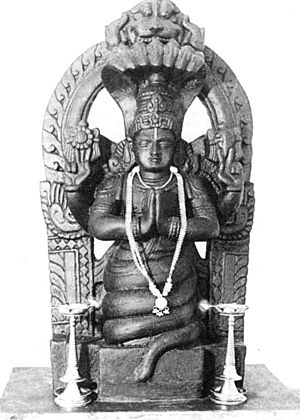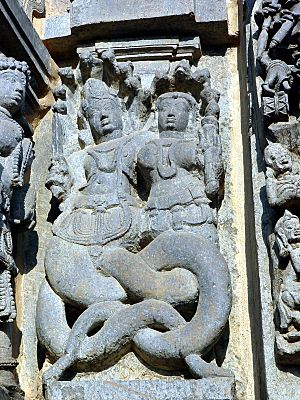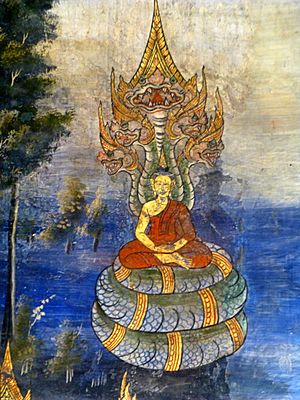Nāga facts for kids
Nagas are special beings, like gods, found in stories and religions like Hinduism, Buddhism, and Jainism. They are often seen as snake-like beings or snake gods. They live deep in the ocean and underground in a hidden world called "Patala". Sometimes, they can even change into human form!
Nagas can look different:
- They might be human with snakes on their head or neck.
- They can be full snakes.
- Or they can be half-human and half-snake.
A female naga is called a nagi or nagini. A nagaraja is a king of the nagas. They are very important in many old Indian stories and religions.
Nagas in Hinduism

Nagas are very common in Hindu stories and art. They are described as strong and special beings who can change their shape. They live in a magical underground world. This world is full of jewels, gold, and other treasures. It is called "Naga-loka" or "Patala-loka". Nagas are often seen as guardians of treasure and keepers of magic. You can often find them in stories about lakes and oceans.
Nagas have great power and venom, which can be dangerous to humans. However, many nagas are kind and helpful. For example, in the story called Samudra manthan, the great Naga King Vasuki helped the gods and demons. He let them use his body as a rope to churn the Ocean of Milk. This helped them get a special drink that made them immortal.
The nagas have eternal enemies called the garudas. Garudas are powerful bird-like gods.
The god Vishnu is often shown resting under the hood of the great naga Shesha. Sometimes he is even shown lying on Shesha. This special connection between serpents and gods is also seen with other deities. For example, the serpent is often part of art featuring the god Ganesha.
Nagas in Buddhism
Nagas are also important in Buddhism. They usually appear as giant cobras. They can have one head or many heads. Sometimes, nagas use their magic to turn into human form. In English, nagas are often called "dragons". Across Asia, people often see them as the same as dragons.
It is believed that nagas live both underground in their own world and in the human world. Some live in caves and caverns. Others live in water, like oceans and lakes.
Nagas are followers of Virupaksha. He is one of the Four Heavenly Kings. They also guard Mount Sumeru. They protect the devas (gods) of Trayastrimsha heaven from the asuras (demons).
There is a story about a naga who appeared as a human. He wanted to become a Buddhist monk. The Buddha told him that only humans could become monks. The naga then promised to follow the five precepts. He hoped to be reborn as a human in a future life. This way, he could become a monk.
Another story is from the Lotus Sutra. It tells of an eight-year-old daughter of a dragon king. She transforms into a male bodhisattva (a person on the path to becoming a Buddha). Then, she becomes enlightened. This story might show the idea that a person needed a male body to become a Buddha.
One famous naga in Buddhism is Mucalinda. He is a Naga King and a protector of the Buddha. In the Vinaya Sutra, King Mucalinda used his hood and seven heads. He sheltered the Buddha from a big storm. After the storm, the king took the form of a young Brahmin and showed respect to the Buddha.
It is also said that a wise teacher named Nāgārjuna received special Buddhist texts. These texts were called the Prajñāpāramitā sutras. Nagas were guarding them after the Buddha had left the world.
Images for kids
-
Mucalinda sheltering Gautama Buddha (Buddha in Naga Prok attitude) at Wat Phra That Doi Suthep in Chiang Mai, Thailand.
-
Nāga at the steps of a building in the Wat Phra Kaew in Bangkok.
-
Cambodian seven-headed naga at the Royal Palace in Phnom Penh.
-
Crowned golden nāga-woodcarving at Keraton Yogyakarta, Java.
-
Bakunawa hilt from a Visayan (Panay) tenegre sword.
-
A sign featuring Nāgas by the Mekong River, Nong Khai Province, Thailand: Nāgas and the Mekong are strongly associated in local beliefs.
-
Royal Barge Anantanakkharat at National Museum of Royal Barges, Bangkok.
-
Nāga sculpture at Suvarnabhumi airport.
-
Nāga, Himmapan animal on Royal Crematorium King Rama IX.
-
Garuḍa devouring Nāga, at Wat Phra Kaew.
-
Naga and Nagini in Bhubaneswar, Odisha.
-
Naga guarding Anouvong's Wat Sisaket in Vientiane.
-
Naga at the funeral of King Bhumibol Adulyadej of Thailand in 2017.
See also
 In Spanish: Naga (mitología hinduista) para niños
In Spanish: Naga (mitología hinduista) para niños
























